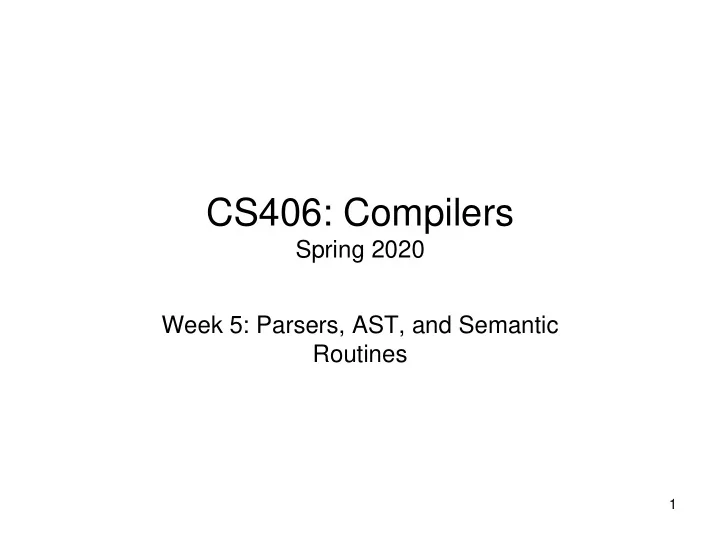

CS406: Compilers Spring 2020 Week 5: Parsers, AST, and Semantic Routines 1
Recap 2
3
Top-down Parsing – predictive parsers 4 Suggested reading: https://en.wikipedia.org/wiki/LL_parser
Top-down Parsing – contd.. • Also called recursive-descent parsing • Equivalent to finding the left-derivation for an input string – Recall: expand the leftmost non-terminal in a parse tree – Expand the parse tree in pre-order i.e. identify parent nodes before children 5
Top-down Parsing ( ) a + $ 1) S -> F 2) S -> (S + F) S 2 - 1 - - 3) F -> a string: (a+a) F - - 3 - - string’ : (a+a)$ Assume that the table is given. • Table- driven (Parse Table) approach doesn’t require backtracking But how do we construct such a table? 6
7
8
9
Computing Parse-Table x y a b c $ 1) S -> ABc$ 2) A -> xaA S 1 1 1 3) A -> yaA A 2 3 4 4) A -> c 5) B -> b B 5 6 6) B -> λ first (S) = {x, y, c} follow (S) = {} P(1) = {x,y,c} first (A) = {x, y, c} follow (A) = {b, c} P(2) = {x} first(B) = {b, λ } follow(B) = {c} P(3) = {y} P(4) = {c} P(5) = {b} P(6) = {c} 10
Parsing using stack-based model (non-recursive) of a predictive parser 11
Computing Parse-Table string: xacc$ Stack* Remaining Input Action S xacc$ Predict(1) S->ABc$ ABc$ xacc$ Predict(2) A->xaA xaABc$ xacc$ match(x) aABc$ acc$ match(a) ABc$ cc$ Predict(4) A->c cBc$ cc$ match(c) Bc$ c$ Predict(6) B-> λ c$ c$ match(c) c$ c$ Done! 12 * Stack top is on the left-side (first character) of the column
Identifying LL(1) Grammar • What we saw was an example of LL(1) Parser • Not all Grammars are LL(1) A Grammar is LL(1) iff for a production A -> α | β , where α and β are distinct: For no terminal a do both α and β derive strings beginning with 1. a At most one of α and β can derive an empty string 2. then α does not derive any string beginning with a 3. If terminal in Follow(A). If then does not derive any string beginning with a terminal in Follow(A) 13
14
Example (Left Factoring) 15
Eliminating Left Recursion A -> A α | β A -> βA’ A’ -> αA’ | λ 16
17
18
19
20
21
22
Example: E -> E + T | T T -> T * F | F F -> (E) | id String: id*id Demo 23
• Basic idea: put tokens on a stack until an entire production is found - shift tokens onto the stack. At any step, keep the set of productions that could generate the read-in token - reduce the RHS of recognized productions to the corresponding non-terminal on the LHS of the production. Replace the RHS tokens on the stack with the LHS non- terminal. • Issues: 24
25
26
27
28
29
30
Abstract Syntax Trees • Parsing recognizes a production from the grammar based on a sequence of tokens received from Lexer • Rest of the compiler needs more info: a structural representation of the program construct • Abstract Syntax Tree or AST 31
Abstract Syntax Trees • Are like parse trees but ignore certain details • Example: E -> E + E | (E) | int String: 1 + (2 + 3) Demo 32
Semantic Actions for Expressions 33
Review • Scanners • Detect the presence of illegal tokens • Parsers • Detect an ill-formed program • Semantic actions • Last phase in the front-end of a compiler • Detect all other errors What are these kind of errors? 34
What we cannot express using CFGs • Examples: • Identifiers declared before their use (scope) • Types in an expression must be consistent • Number of formal and actual parameters of a function must match • Reserved keywords cannot be used as identifiers • etc. Depends on the language.. 35
abstract syntax tree 36
Scope • Scope of an identifier is the part of the program where the identifier is accessible • Multiple scopes for same identifier name possible • Static vs. Dynamic scope exercise: what are the different scopes in Micro? 37
Types • Static vs. Dynamic • Type checking • Type inference 38
in Λ 39
Expressions Example x + y + 5 40
Expressions Example x + y + 5 identifier “x” 41
Expressions Example x + y + 5 identifier “x” identifier “y” 42
Expressions Example x + y + 5 binary_op operator: + identifier “x” identifier “y” 43
Expressions Example x + y + 5 binary_op literal “5” operator: + identifier “x” identifier “y” 44
Expressions Example x + y + 5 binary_op operator: + binary_op literal “5” operator: + identifier “x” identifier “y” 45
Suggested Reading • Alfred V. Aho, Monica S. Lam, Ravi Sethi and Jeffrey D.Ullman: Compilers: Principles, Techniques, and Tools, 2/E, AddisonWesley 2007 – Chapter 4 (4.5, 4.6 (introduction)). Chapter 5 (5.3), Chapter 6 (6.1) • Fisher and LeBlanc: Crafting a Compiler with C – Chapter 8 (Sections 8.1 to 8.3), Chapter 9 (9.1, 9.2.1 – 9.2.3) 46
Recommend
More recommend